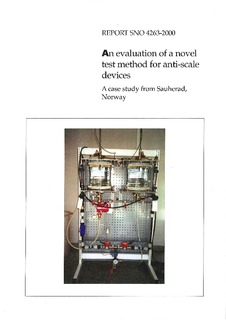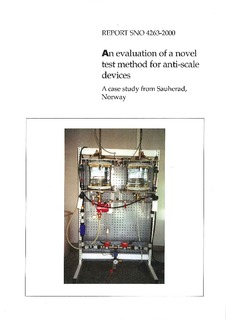| dc.contributor.author | Mohn, H. | nb_NO |
| dc.contributor.author | Stene-Johansen, S. | nb_NO |
| dc.contributor.other | Mohn, H. - Project manager | nb_NO |
| dc.coverage.spatial | Telemark | nb_NO |
| dc.date.accessioned | 2014-08-01T10:45:28Z | |
| dc.date.available | 2014-08-01T10:45:28Z | |
| dc.date.issued | 2000 | nb_NO |
| dc.identifier | 4263 | nb_NO |
| dc.identifier.isbn | 82-577-3890-5 | nb_NO |
| dc.identifier.issn | 1894-7948 | nb_NO |
| dc.identifier.uri | http://hdl.handle.net/11250/210951 | |
| dc.description | Årsliste 2000 | nb_NO |
| dc.description.abstract | The Danish Technological Institute (DTI) and The Norwegian Institute for Water Research (NIVA) have developed a test method based on research from Cranfield University about magnetic fields applied on re-circulation systems and DVGW W512 for evaluating anti-scale devices for hot water treatment. Test results and experiences from two tests conducted in a Norwegian municipality with scaling problems in hot water installations are presented. During the first test an old magnetic anti-scale device was examined without re-circulation. Scales were formed on the heater elements both for the treated and non-treated water (control), although the anti-scale device reduced the scale formation in one case. 3.7% and 5.0% of the influent calcium were converted into scales in the line with and without an anti-scale device, respectively. During the second test a new anti-scale device was examined with re-circulation. Here, the scale formation from the treated water in fact increased. During re-circulation 11.9% and 7.0% of the influent calcium were converted into scales in the line with and without an anti-scale device, respectively. The anti-scale devices were not able to prevent scale formation on the heater elements in the test rig. The results raise some questions about the efficiency of the tested anti-scale devices and the test methodology itself. To gain more experiences with this system the tests should be repeated with various anti-scale devices, and the system itself should be tested with pressurized water. | nb_NO |
| dc.description.sponsorship | Nordtest | nb_NO |
| dc.publisher | Norsk institutt for vannforskning | nb_NO |
| dc.relation.ispartofseries | NIVA-rapport;4263 | nb_NO |
| dc.rights | Navngivelse-IkkeKommersiell-DelPåSammeVilkår 3.0 Norge | nb_NO |
| dc.rights.uri | http://creativecommons.org/licenses/by-nc-sa/3.0/no/ | nb_NO |
| dc.subject | vannforsyning | nb_NO |
| dc.title | An evaluation of a novel test method for anti-scale devices.- A case study from Sauherad, Norway | nb_NO |
| dc.type | Research report | nb_NO |
| dc.rights.holder | Norsk institutt for vannforskning/Norwegian institute for water research | nb_NO |
| dc.subject.nsi | VDP::Matematikk og naturvitenskap: 400 | nb_NO |
| dc.source.pagenumber | 14 | nb_NO |
| dc.subject.keyword | varmtvannsberedere | nb_NO |
| dc.subject.keyword | kalkavleiringer | nb_NO |
| dc.subject.keyword | magnetiske avkalkere | nb_NO |
| dc.subject.keyword | test metode | nb_NO |
| dc.subject.keyword | nordtest | nb_NO |
| dc.subject.keyword | hot | nb_NO |
| dc.subject.keyword | water | nb_NO |
| dc.subject.keyword | tanks | nb_NO |
| dc.subject.keyword | scale | nb_NO |
| dc.subject.keyword | formation | nb_NO |
| dc.subject.keyword | magnetic | nb_NO |
| dc.subject.keyword | anti-scale | nb_NO |
| dc.subject.keyword | devices | nb_NO |
| dc.subject.keyword | test | nb_NO |
| dc.subject.keyword | method | nb_NO |
| dc.relation.project | O-99039 | nb_NO |


